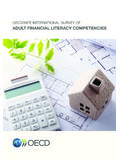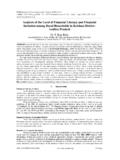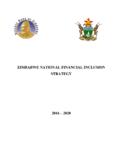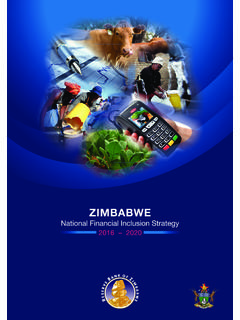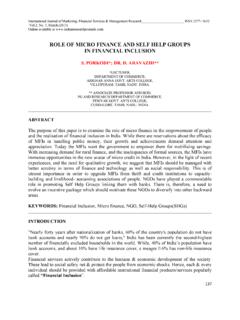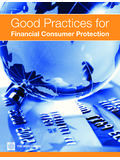Transcription of FINANCIAL INCLUSION AND CONSUMER EMPOWERMENT …
1 G20/OECD INFE CORE FINANCIAL INCLUSION AND CONSUMER EMPOWERMENT IN SOUTHEAST ASIA This paper is published under the responsibility of the Secretary-General of the OECD. The opinions expressed and the arguments employed herein do not necessarily reflect the official views of OECD member countries. This document and any map included herein are without prejudice to the status of or sovereignty over any territory, to the delimitation of international frontiers and boundaries and to the name of any territory, city or area. OECD 2018. Applications for permission to reproduce or translate all or part of this material should be made to: Please cite this publication as: OECD (2018).
2 FINANCIAL INCLUSION and CONSUMER EMPOWERMENT in Southeast Asia. 3 Foreword In recent years, FINANCIAL INCLUSION levels have improved in all Southeast Asian countries, even though these levels remain relatively low in some countries. FINANCIAL literacy also remains low and FINANCIAL CONSUMER protection frameworks are weak in some of these countries, with uneven regulation of FINANCIAL providers, low disclosure requirements, and, in some cases, questionable business practices. FINANCIAL INCLUSION , FINANCIAL CONSUMER protection and FINANCIAL literacy polices need to evolve in parallel if they are to contribute to the FINANCIAL well-being of the population and to inclusive growth. The OECD International Network on FINANCIAL Education (OECD/INFE) has been working on the demand side of FINANCIAL INCLUSION since its creation in 2008.
3 The OECD/INFE develops of research, policy guidance and tools to support FINANCIAL INCLUSION through improved FINANCIAL literacy, focusing in particular on vulnerable groups and the digitalisation of FINANCIAL services. The OECD-ADBI-SBV Conference on FINANCIAL Literacy and CONSUMER Protection held in Hanoi, Viet Nam on 3-4 October 2017, co-organised by the OECD/INFE, the Asian Development Bank Institute (ADBI) and the State Bank of Viet Nam (SBV), contributed further to this work. The conference focused primarily on the role of FINANCIAL education and FINANCIAL CONSUMER protection in supporting effective FINANCIAL INCLUSION through CONSUMER EMPOWERMENT in the current digital context, looking especially at examples from Asia to support policies in Viet Nam and other countries in the region.
4 This paper was commissioned to provide evidence and research for the conference, focusing particularly on countries within the Association of South East Asian Nations (ASEAN). The paper was supported by the Japanese government and prepared by Elizabeth Ooi, Lecturer in Finance at the University of Western Australia. Expert input was provided by Adele Atkinson and Chiara Monticone and oversight by Flore-Anne Messy from the OECD Directorate for FINANCIAL and Enterprise Affairs. Editorial support within the OECD was provided by Pamela Duffin, Jennah Huxley and Lynn Kirk. Data for Cambodia and Viet Nam were provided by the Asian Development Bank Institute with the agreement of the National Bank of Cambodia and the State Bank of Viet Nam.
5 4 Table of contents Foreword .. 3 Executive summary .. 6 I. Introduction .. 8 Background to this paper .. 8 The importance of FINANCIAL INCLUSION .. 9 FINANCIAL CONSUMER protection and FINANCIAL education for promoting FINANCIAL INCLUSION .. 10 Structure of this 10 II. The current situation .. 11 FINANCIAL literacy in ASEAN countries .. 12 FINANCIAL INCLUSION and access in ASEAN countries .. 18 III. Policies in ASEAN countries .. 23 FINANCIAL INCLUSION .. 23 FINANCIAL education .. 26 FINANCIAL CONSUMER protection .. 26 IV. Approaches to improve FINANCIAL INCLUSION through FINANCIAL education initiatives .. 30 Evaluated FINANCIAL education initiatives .. 30 Other FINANCIAL education initiatives.
6 32 V. Policy suggestions .. 38 References .. 41 Appendix A1. Percentage of respondents per country .. 45 Appendix A2. Computing a FINANCIAL knowledge score .. 46 Appendix A3. Computing a FINANCIAL behaviour score .. 47 Appendix A4. Computing a FINANCIAL attitudes score .. 49 Appendix A5. Measuring FINANCIAL INCLUSION indicators .. 50 5 Tables Table 1. Mean and minimum target scores on FINANCIAL knowledge .. 14 Table 2. Percentage of correct responses to FINANCIAL knowledge questions .. 14 Table 3. Self-reported FINANCIAL knowledge .. 15 Table 4. Mean and minimum target scores on FINANCIAL behaviour .. 15 Table 5. Percentage of respondents who engage in a behaviour or who agree with FINANCIAL behaviour statements.
7 16 Table 6. Choosing FINANCIAL products in selected ASEAN countries .. 17 Table 7. Mean and minimum target scores on FINANCIAL attitudes .. 17 Table 8. Percentage of responses who disagree with FINANCIAL attitude statements .. 18 Table 9. World Bank FINANCIAL INCLUSION indicators in ASEAN (2014) .. 19 Table 10. Deposit account holding with commercial banks in selected ASEAN countries .. 19 Table 11. Percentage of financially included .. 20 Table 12. Knowledge of interest and holding/choosing interest products .. 21 Table 13. FINANCIAL access index scores in ASEAN countries .. 22 Table 14. FINANCIAL INCLUSION policies in ASEAN .. 24 Table 15. National strategies in the ASEAN region .. 26 Table 16.
8 Ranking of regulatory and supervisory frameworks for supporting FINANCIAL INCLUSION in selected ASEAN countries .. 28 Figures Figure 1. FINANCIAL literacy scores in selected ASEAN countries .. 13 Boxes Box 1. Digital FINANCIAL INCLUSION and FINANCIAL education initiatives .. 25 Box 2. Digital FINANCIAL education initiatives .. 35 Box 3. Education initiatives on CONSUMER rights and responsibilities* .. 36 6 Executive summary FINANCIAL education and FINANCIAL CONSUMER protection are essential ingredients in supporting FINANCIAL INCLUSION , especially in the context of the advancement of digital FINANCIAL services. An effective regulatory and policy environment can improve the supply of appropriate FINANCIAL products and services to all, especially to those most in need, and encourage the use of new technologies in an inclusive way.
9 A strong and responsive FINANCIAL CONSUMER protection framework can also promote trust and confidence in the FINANCIAL system and significantly reduce the likelihood of CONSUMER detriment. FINANCIAL education also supports INCLUSION by equipping individuals with an understanding of how FINANCIAL products may benefit them. It can provide the knowledge and skills to use FINANCIAL products and services effectively and with a greater awareness of their rights and responsibilities in FINANCIAL markets. This is especially relevant in ASEAN countries, many of which have low, but rapidly increasing, levels of access to FINANCIAL services. This report begins by investigating the current situation of FINANCIAL INCLUSION and FINANCIAL literacy in ASEAN countries.
10 FINANCIAL literacy levels in the five ASEAN countries that participated in the OECD/INFE FINANCIAL literacy survey Cambodia, Indonesia, Malaysia, Thailand and Viet Nam are lower than average levels in participating OECD and non-OECD countries around the world. FINANCIAL literacy is especially low in Cambodia and Viet Nam. In the five ASEAN countries, scores in FINANCIAL knowledge and behaviour tend to be positively correlated with income and education levels, whereas gender differences are minimal. Across the ASEAN, FINANCIAL INCLUSION is relatively high in Malaysia, Singapore and Thailand and quite low in Cambodia, the Lao PDR, Myanmar and Viet Nam.










